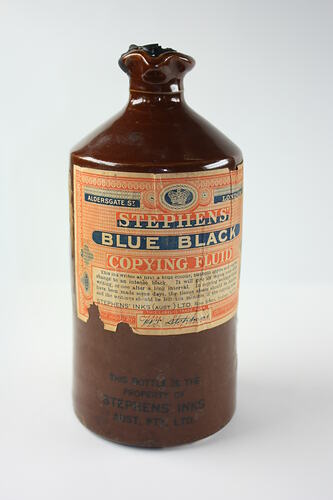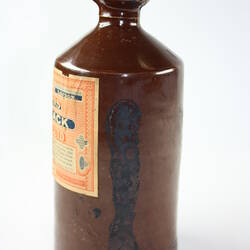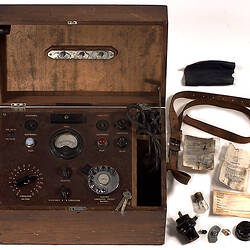Summary
Bottle of blue ink. Made or distributed by Stephens' Inks (Aust) Ltd., circa 1848-1950. Probably used in the office of a Victorian psychiatric hospital, circa 1880s-1940s.
'Stephens' Ink' was invented by the British physician, Dr Henry Stephens (1796-1864), who in 1832 first developed his indelible "blue-black writing fluid" that became the basis of a successful manufacturing enterprise lasting over 130 years. Stephens' ink revolutionised office life in the latter half of the 19th century saving clerical workers much time previously spent mixing powdered inks and cleaning nibs. Being indelible and non-fading, Stephens' ink was made mandatory by the British government for all for legal documents and ships' log books.
In 1848, Dr Stephens moved production of his inks to Finchley in North London, were he bought and renovated Grove House, establishing a laboratory amongst the outbuildings for his personal research into new recipes for making inks and wood stains. After Dr Stephens collapsed and died at Farringdon Station in 1864, the business was taken over by his son Henry Charles Stephens (1841-1918) who turned the business into an international operation, making 'Stephens' Ink' a household name throughout the world. In the early 1880s, the ink factory and offices of H.C. Stephens moved from Aldersgate Street, London, to 275 Holloway Road, Holloway, and then in 1892 the factory moved again to nearby Gillespie Road. Popularly known as "Inky" Stephens, Henry Charles served as a conservative British MP from 1887-1900 and was a prominent local figure around Finchley. In 1874 he bought Avenue House at Finchley, with 10 acres of adjoining land that he turned into extensive gardens and upon his death bequeathed the house and grounds to the local community - it today operates as a museum housing the Stephens Collection.
Imported Stephens' Ink was being advertised in Australian newspapers as early as the 1850s. The company exhibited at the Sydney International Exhibition of 1879 and later established a distribution office in Sydney that was managed by William Mould in the early 20th century. After changes to the Australian import duties on inks, a local manufacturing works was established in the early 1930s by Stephens Inks (Australia) Ltd. and in 1935, the company had a new two storey factory designed by architects B.B. Wilshire & N. Hodges built on the Pacific Highway, North Sydney. The ink was sold in locally-made glass bottles that remained the property of the company and were collected for reuse.
Physical Description
Ink is in a round, brown pottery bottle with a pourer lip. Sealed with a cork. Contents: appears full. Ink is lead based.
More Information
-
Collection Names
-
Collecting Areas
-
Acquisition Information
Donation from Office of Psychiatric Services, May 1985
-
Manufacturer
H.C. Stephens, Aldergate Street, London, England, Great Britain, London, Australia, circa 1900s
-
Distributor
Stephens' Inks (Aust) Ltd., Sydney, Greater Sydney, New South Wales, Australia, circa 1930s
-
Place & Date Used
-
Inscriptions
ALDERSGATE ST LONDON/STEPHEN'S/BLUE BLACK/COPYING FLUID/This ink writes at first a blue colour [extensive text] printed on label.
-
Brand Names
-
Classification
Medicine & health, Mental health - administration, Stationery
-
Category
-
Discipline
-
Type of item
-
Overall Dimensions
9 cm (Length), 20 cm (Height)
-
Keywords
Bottles, Pottery, Psychiatric Hospitals, Stationery, Writing Equipment, Inks, Making History - Psych Services




